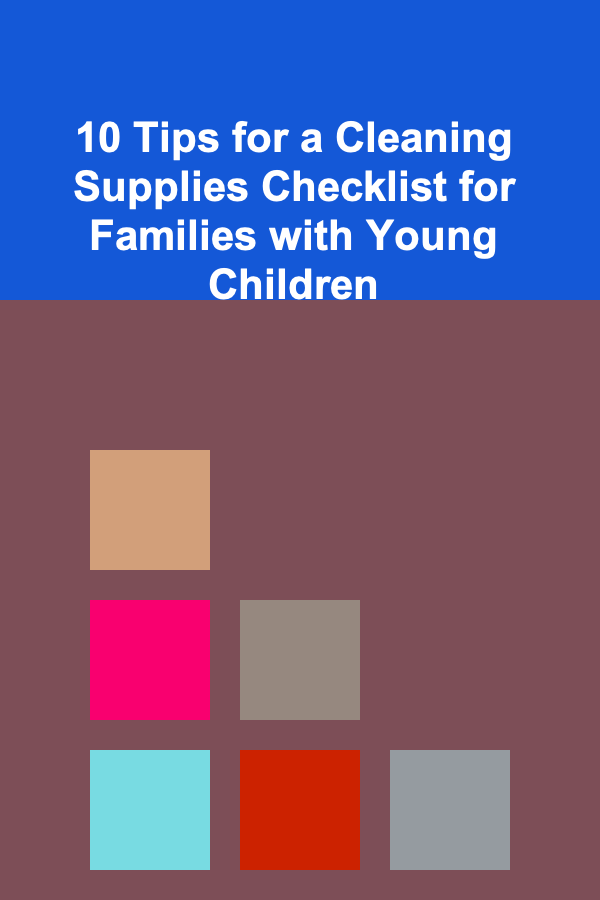
10 Tips for a Cleaning Supplies Checklist for Families with Young Children
ebook include PDF & Audio bundle (Micro Guide)
$12.99$8.99
Limited Time Offer! Order within the next:

Keeping a home clean and safe is a top priority for families with young children. However, it's crucial to ensure that the cleaning supplies used are not only effective but also safe for the little ones who are constantly exploring their environment. With toddlers and babies crawling, playing, and often putting things in their mouths, the need for non-toxic, child-friendly cleaning supplies becomes even more important.
This article provides 10 essential tips for creating a comprehensive cleaning supplies checklist that balances cleaning efficiency with the safety of young children.
Choose Non-Toxic Cleaning Products
One of the most important tips when selecting cleaning supplies for homes with young children is to choose products that are non-toxic. Traditional cleaning products can contain harmful chemicals like ammonia, bleach, and phthalates, which may pose a health risk if ingested, inhaled, or absorbed through the skin. Children are particularly vulnerable to these chemicals, which is why it's essential to use non-toxic, child-safe alternatives. Look for cleaning products labeled as:
- Eco-friendly: These products are often free of harsh chemicals and use plant-based ingredients.
- Non-toxic: Ensure the label specifically mentions that the product is safe for children and pets.
- Hypoallergenic: This is especially important if your child has sensitive skin or allergies.
Many brands now offer child-safe cleaning options, such as Method, Mrs. Meyer's, and Seventh Generation. These products provide peace of mind without sacrificing cleaning power.
Invest in Multi-Purpose Cleaners
When shopping for cleaning supplies, it's often better to choose multi-purpose cleaners that can be used throughout the house. These cleaners are versatile and can handle various surfaces, from countertops and kitchen tables to floors and windows. Investing in a multi-purpose cleaner reduces the number of individual products you need to keep in your home, which is both cost-effective and space-saving.
Look for multi-purpose cleaners that are:
- Safe for food-contact surfaces: Kitchen counters, dining tables, and high chairs require a cleaner that is safe around food.
- Strong on stains: Children's messes often involve sticky, greasy, or colored substances. A powerful yet safe multi-surface cleaner will help with tough spots.
Opting for one high-quality product that does it all can simplify your cleaning routine and keep your home tidy and child-friendly.
Keep Disinfectants Child-Safe
Disinfecting is an essential part of keeping your home free from germs, especially with young children who are more likely to get sick. However, traditional disinfectants often contain strong chemicals that are not safe for kids. When choosing disinfectants for your home, make sure they are child-safe and designed for use in homes with young children.
Look for disinfectants that are:
- EPA-approved for household use: The Environmental Protection Agency (EPA) has a list of disinfectants that are safe and effective against harmful bacteria and viruses. Ensure the product you choose is listed as safe for home use and effective in killing germs.
- Child-safe: Always read the label to confirm that the product is child-friendly. Some disinfectants come in sprays or wipes that can be safely used around children, but it's important to ensure that they don't leave harmful residues or fumes.
Consider using natural disinfectants like vinegar, tea tree oil, or hydrogen peroxide, which can be just as effective without the risk of harmful chemicals.
Select Gentle Floor Cleaners
When it comes to floor cleaning, children spend a significant amount of time on the floor crawling, walking, and playing. For this reason, it's vital to choose floor cleaners that are gentle yet effective, and safe for your little ones. Harsh floor cleaners can leave residues that may come into contact with your child's skin, and potentially cause irritation or allergic reactions.
Opt for:
- Non-toxic, baby-safe floor cleaners: Products like baby-safe floor wipes or liquid cleansers that are free of harsh chemicals are perfect for cleaning floors without risk to your child.
- Natural floor cleaners: Some natural alternatives, such as diluted vinegar or a mixture of water and a mild dish soap, can be very effective for cleaning hard floors.
- pH-balanced products: Look for cleaners with a balanced pH, which are gentle on both floors and your child's skin.
Ensuring that your floor cleaners are non-toxic will give you the confidence that your child is not exposed to potentially harmful substances while playing or crawling.
Use Safe Glass and Mirror Cleaners
Children love to leave their mark on glass surfaces, whether it's smudging windows or putting fingerprints on mirrors. While it's essential to clean these surfaces frequently, many traditional glass cleaners contain ammonia and other chemicals that could be harmful if inhaled or ingested by children.
To avoid these risks, use:
- Ammonia-free glass cleaners: Many brands now offer glass cleaners that are free of ammonia, which is a potent chemical. These products are just as effective but safer for children.
- Natural alternatives: You can make your own glass cleaner by mixing equal parts water and vinegar. This solution is a great non-toxic alternative that's both safe for children and effective at cutting through grease and grime.
By opting for ammonia-free or natural glass cleaners, you protect your children from exposure to harsh chemicals while keeping your home sparkling clean.
Consider Fragrance-Free or Low-Scent Products
Many cleaning products on the market come with strong artificial fragrances. While these scents may seem pleasant, they can cause irritation for young children, particularly those with allergies, asthma, or sensitive skin. Strong scents can also be overwhelming for children, causing discomfort or respiratory problems.
To avoid this, opt for:
- Fragrance-free or low-scent cleaning products: Many cleaning brands now offer fragrance-free or lightly scented options that are safe for children. These products are often free from phthalates, which are chemicals used to create strong scents in cleaning products.
- Essential oil-based cleaners: If you prefer a natural scent, consider using cleaners with essential oils like lavender or eucalyptus, which are safe and gentle when used in moderation.
Choosing fragrance-free or naturally scented products helps ensure your child is not exposed to potentially harmful chemicals, while still keeping your home fresh and clean.
Invest in Microfiber Cloths
Microfiber cloths are an excellent tool for cleaning because they are gentle, highly absorbent, and capable of trapping dirt and debris without the need for harsh cleaning chemicals. When you use microfiber cloths, you can clean many surfaces with just water, reducing your reliance on chemical cleaners.
Benefits of microfiber cloths include:
- Gentle on surfaces: Microfiber cloths are safe for delicate surfaces, including countertops, appliances, and children's toys.
- Effective cleaning power: These cloths pick up dirt and dust effectively, meaning you can clean with less effort and fewer cleaning products.
- Washable and reusable: Microfiber cloths are washable and reusable, which makes them both eco-friendly and cost-effective.
By incorporating microfiber cloths into your cleaning routine, you reduce the amount of cleaning products you need, while still maintaining a clean, healthy home for your child.
Keep Cleaning Supplies Out of Reach
Even the safest cleaning products can pose a risk if children come into contact with them. To ensure your child's safety, always store cleaning supplies out of their reach. Here are a few tips:
- Use high cabinets: Store cleaning products in high cabinets or cupboards with secure latches.
- Invest in childproof locks: If you have cabinets that contain cleaning supplies at a lower level, make sure to install childproof locks to prevent access.
- Store in designated areas: Keep all cleaning products in a designated area, such as a closet or pantry, that is locked or out of reach of children.
By taking these steps, you can keep your cleaning supplies safe and ensure that your child is not exposed to potentially harmful chemicals.
Be Mindful of Laundry Detergents and Fabric Softeners
Young children tend to have sensitive skin, and many standard laundry detergents and fabric softeners contain fragrances and chemicals that can cause irritation. When selecting laundry products, look for options that are gentle on your child's skin.
Consider using:
- Hypoallergenic, baby-friendly detergents: Many baby laundry detergents are specifically formulated to be gentle on sensitive skin. These products are free of dyes, fragrances, and harsh chemicals.
- Eco-friendly fabric softeners: Fabric softeners with natural ingredients or essential oils can help reduce the harsh chemicals found in traditional softeners.
By using baby-friendly laundry products, you can reduce the risk of skin irritation and ensure your child's clothes are safe and soft.
Regularly Update Your Cleaning Supplies
As your child grows, their needs and the cleaning requirements of your home will change. It's essential to regularly assess your cleaning supplies to ensure they continue to meet your needs and are safe for your child's development. Check the expiration dates on products, and replace anything that has been in use for too long or that no longer works effectively.
In addition to this, reassess the products you use based on your child's age, developmental stage, and any new sensitivities they may have.
By following these 10 tips for a cleaning supplies checklist, families with young children can maintain a clean and safe environment without compromising on the health and safety of their little ones.
Reading More From Our Other Websites
- [Home Renovating 101] How to Refinish Wood Floors for a Fresh Look Without Replacing Them
- [Home Lighting 101] How to Use Patio Lighting to Create Different Moods and Ambiance for Outdoor Gatherings
- [Home Staging 101] How to Stage Your Home's Dining Area for Family Gatherings
- [Home Cleaning 101] How to Maintain a Minimalist Home Cleaning Routine
- [Home Space Saving 101] How to Organize Your Jewelry Collection in Small Spaces
- [Home Space Saving 101] How to Use Folding Furniture to Save Space
- [Personal Care Tips 101] How to Choose a Body Spray for a Tropical or Exotic Feel
- [Home Pet Care 101] How to Use Pet Obesity Facts to Start a Home Weight Loss Journey for Your Beloved Companion
- [Home Storage Solution 101] How to Master Basket Storage Ideas for Every Room: A Guide to Stylish Organization
- [Organization Tip 101] How to Prioritize Home Maintenance Tasks with a Checklist

How to Add Holiday Cheer to Your Bathroom with Simple Decor
Read More
How to Use Color-Coding for Easy Organization
Read More
Make Money with Deep Learning: Start Your Own AI SaaS Business
Read More
Unlocking Success as a Customer Success Manager: A Comprehensive Guide to Client Engagement
Read More
How To Learn Zorbing: Rolling Downhill in a Ball
Read More
How to Create a Chore Chart That Actually Works for Your Kids
Read MoreOther Products

How to Add Holiday Cheer to Your Bathroom with Simple Decor
Read More
How to Use Color-Coding for Easy Organization
Read More
Make Money with Deep Learning: Start Your Own AI SaaS Business
Read More
Unlocking Success as a Customer Success Manager: A Comprehensive Guide to Client Engagement
Read More
How To Learn Zorbing: Rolling Downhill in a Ball
Read More